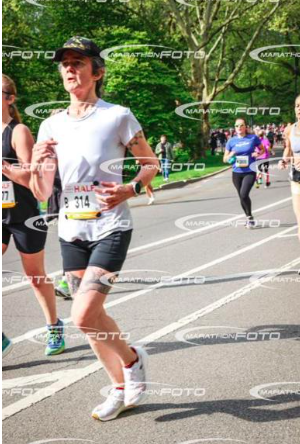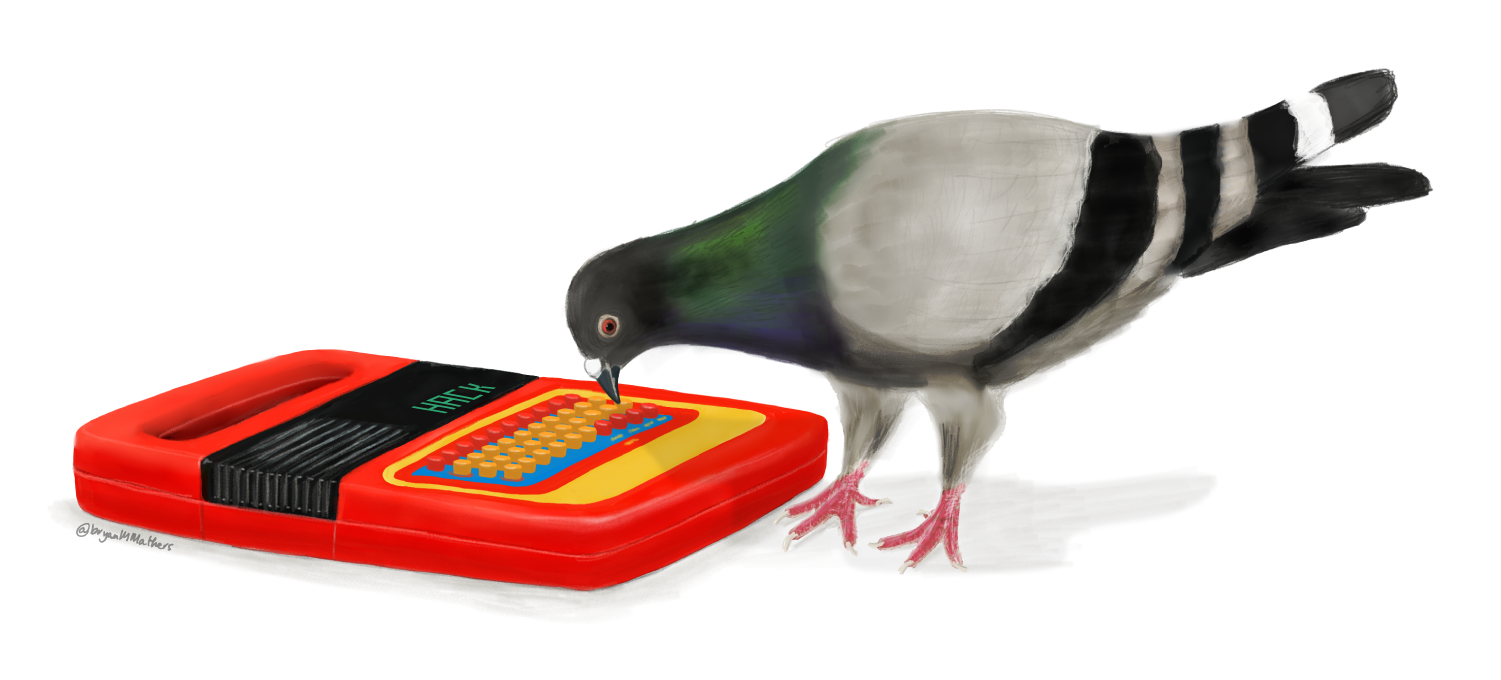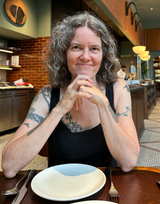The Race Report

Last Sunday’s Real Simple Women’s Half Marathon was my fourth race at that distance. And it was my fourth best time.
Yes, that’s me, trying to put a positive spin on a rather challenging day that came at the end of a very challenging training block that comes at the start of an incredibly challenging month ahead: the fourth anniversary of Isaiah’s death, Mother’s Day, his birthday all in succession in the coming weeks.
So it’s not surprising (but it's still frustrating) that I was in not able to perform at my best in this race, having lost weeks of progress to an injury that, to be honest, I’m not entirely sure I’ve recovered from. I mean, my knee does not hurt at all when I run, but when I kneel – to do lunges, for example – I can tell that there is still some lingering inflammation in the bursa. My hips – flexors and extensors – are ridiculously tight too, and my stride feels very clipped. Broken body aside, it’s the mental fallout from everything that’s depleted my strength and stamina the most, I think – not just my fall, but that other one too. I’m back in therapy, which is very good but very hard. Frankly, I’m a mess.
Even before the official race time informed me that I was far off from my pace in my previous half marathon, I knew that I had slowed down considerably. I knew that in my body. I didn’t need my Garmin to tell me, although I’d strapped it back on for some of my final long runs, and it greeted me with all sorts of negative messaging about my condition and conditioning, all while predicting that I could still run 13.1 miles in about an hour and fifty minutes. Clearly, it was just making shit up.

The Race Report
New York Road Runners' races are quite large, even the non-marquee events like the women's half; and runners are always divided into corrals at the start based on their previous best pace – faster races start at the front so they don't have to dodge and weave as much. Normally, I’m in Corral D, but as there were no men in this race, I was up with Corral B, which was both psychologically uplifting and terrifying. But knowing that I wouldn’t be running my fastest, I stood in the back of the corral, giving other, speedier runners an opportunity to go ahead.
No surprise then, the start of the race was slow. Mile 1: 8:41/mi – about ten seconds off from where, at the outset of the training block, I thought I’d be. But I wasn’t too worried. “Start slow” – always solid advice. Then the 1:55 pacer zoomed ahead of me, and I panicked a little. (My initial goal, many months ago now, had been 1:50.) She was really flying, and I... well, I was not. Mile 2 (which included the first big hill): 8:28. Mile 3: 8:08 – a flat stretch, but yikes, too fast. Mile 4 (the dreaded Harlem Hills): 8:30. Mile 5 (the Three Sisters hills along the west side): 8:39. Mile 6: 8:28. One lap done, and I was feeling surprisingly strong.
Sunday’s forecast was warm – perfect for spectating but less than ideal for racing; but it wasn’t too bad at the 8am start – and more importantly, it was still a little overcast as I completed the first 10K. I grabbed water at all the hydration stations nonetheless, going for Gatorade right before the Mile 6 marker. I’d taken my first gel a little earlier, around 40 minutes as planned. But then, as I started the second lap of the park, I began to feel a slight side stitch.
I started to slow down. Mile 7 (Cat Hill, again): 8:38. Mile 8, a flat stretch that should have been fast: 8:54. Mile 9 (Harlem Hills, round two): 8:43. Mile 10 (it sure seemed like there were more than three hills on the west side this time around): 9:05. Mile 11: 9:11. Mile 12: 8:55. Mile 13: 9:00.
The sun had come out. The second gel, taken around Mile 8 I think, was too gross to finish. The stitch was still gnawing at my side, slight but threatening. Around mile 11, the 1:55 pacer passed me (again), and by this time I knew that she wasn’t going too fast. It was me – I was going too slow.
On the second loop, to make things even tougher, I could no longer run the tangents – that's runner-speak for keeping one’s trajectory on the course as short as possible by running straight lines rather than curves. I’d caught up to the slower runners still on their first loop of the course, some of whom were walking three or four abreast. I did not have the energy to weave, but I had to. The course was packed – the number of participants in this year’s race was up 40% from last. The road was full of women’s bodies in motion, which was beautiful but, I'll be honest, kind of frustrating. The hydration stations had become almost impossible to navigate too – you couldn’t run up, grab a cup, and sip it on the go, as runners were huddled around the tables, some completely stopped (which is, I realize, a much more sensible way to drink, but tell that to a runner with a time goal).
The course was split for the final couple hundred meters, with the finishers going left and those who had another lap to go keeping right. I veered, weaving through those who were clearly not reading the signs, for one final little hill before the finish line. I did not have any kick left in me, even though the crowds there were loud and supportive. I got my medal, and wandered around until I found Kin and Poppy, who’d been watching, cheering me on right at Mile 10 when I was starting to feel pretty gloomy.

After a shower and a bagel, Kin and I went out for dim sum – a far, far better way to restore one’s “electrolytes,” I’d argue, than Gatorade.
Final time: 1:55:43. 1257th place overall. 44th in my age group.

Reflections on Training and Performance
After I injured my knee, I switched my goal from “PR” to “Finish the Race.” Once I started running again, the focus of my training became endurance not speed – getting the 13.1 miles done, no matter the pace. In hindsight, this was a mistake, as even once I was clearly on the mend, I didn’t spend any time practicing my “race pace,” only running a single progression run and a fartlek in the final weeks of training. While there’s so much talk about “Zone 2 training” right now – rightly urging people to run most of their runs more slowly – you still do also have to run fast to get fast. One of the reasons you train at "race pace" is not just so your heart and lungs and legs can pull it off, but so your body knows the speed you’re targeting – so it’s, if not comfortable (it is a race, after all), familiar. My neglect of speed work meant that I wasn’t conditioned, physically or psychologically, to actually pull off an 8:30 pace, even though, for the first six miles, I really thought I could do it. Again, in hindsight, I clearly went out too fast; and the last half of the race – that is, from Mile 10 onwards – I was far too slow.
I always hate the photos that are taken of me in a race. I try to smile when I see a photographer, give a good thumbs-up gesture or something. But I always look like I’m suffering, even when I swear I’m not. And the photos from this race definitely show I was working too hard too soon. Lesson learned: do the speed work. (And don’t click on the MarathonFoto emails.)

There are lessons too with regards to my fueling, although I’m not sure what they are. I’ve never had a side stitch before. Ever. It might just be that this was my first really hard exertion in warm weather. I did struggle with the timing of my gels, I guess, as I’d somehow altered the display on my watch and couldn’t see the elapsed time. I was pretty confident I took the first one at 40 minutes in. But the second one? I have no clue. And I’ve never had any issues drinking Gatorade before – it’s not my favorite, sure – but it definitely didn’t sit well with me this time. As that’s what’s offered along the course in all NYRR events, I suppose I will have to figure out if it’s really an issue before I run my next long race. (I could wear my hydration vest and bring my own fluids, but I’ll need to practice doing so while doing longer tempo runs -- the fear of cramping offset by a fear of chafing.)
Some Thoughts on Training Without Technology
I have started wearing my watch again for running -- just for running. I don’t use it to record other workouts. I don’t wear it during the day. I don’t wear it to bed.
I’ve gone about three months without it now, and I’m fine. I’m still very active – no watch and no fitness data hasn’t resulted in no motivation. I don’t really miss many of the metrics that these kinds of gadgets promise will enhance my training and recovery.

Not wearing the watch, and then only wearing it for running, has helped underscore how much of the data that’s presented to me is really about keeping me engaged with the device (and by extension, with the brand) and not so much about my actual health. The “at a glance” interface tells me, on one hand, that my training readiness is “poor,” that my training status is “unproductive,” but when I click for more details, it confesses that it doesn’t actually have enough data to make a determination.
I do know that, if I want to keep working on endurance- and speed-related goals, that I need to track my distance and my pace. The watch works really well for that. But I don’t need it to tell me anything else. Indeed, it can’t tell me what’s going on in my body or in my head or even (LOLSOB) in my heart.
Thanks for reading Second Breakfast. I deeply appreciate every single one of you who's signed up to read these rambling emails as I try hard to figure out what the hell I'm doing with my life. Clearly not becoming a professional runner.





